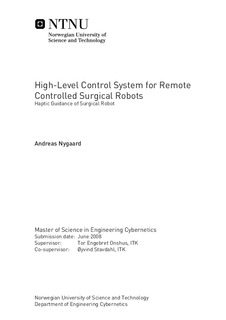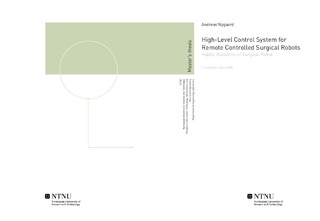| dc.description.abstract | This report considers the work to improve the autonomy of surgical teleoperated systems, by introducing haptic guidance. The use of surgical robots in surgical procedures have become more common the recent years, but still it is in its infancy. Some advantages when using robots is scalability of movements, reduced tremor, better visualisation systems and greater range of motions than with conventional minimally invasive surgery. On the contrary, lack of tactile feedback and highly unstructured medical environment restricts the use of teleoperated robots to specific tasks within specific procedures. A way of improving autonomy of the teleoperated system is to introduce predefined constraints in the surgical environment, to create a trajectory or forbidden area, in order to guide the movements of the surgeon. This is often called haptic guidance. This report introduces the basics of teleoperated systems, with control schemes, models and analytical tools. Algorithms for haptic guidance have been developed, and the entire control and guidance system have been modified and suited for implementation on a real teleoperated system. Theoretical analysis of the position position (PP) control scheme reveals some general stability and performance characteristics, later used as a basis for tuning the real system parameters. The teleoperated system consists of a Phantom Omni device, from SensAble-Technologies, used as master manipulator, and AESOP 3000DS, from Computer Motions Inc., as the slave manipulator. The control system is implemented on a regular PC, connecting the complete system. Tests reveal that the slave manipulator is not suited for this task due to a significant communication time delay, limited velocity and inadequate control possibilities. The consequences makes force feedback based on the PP control scheme impossible, and limits performance of the entire teleoperated system. The guidance system is implemented in two variations, one based on slave positions and one based on master positions. This is motivated to give a performance comparison for variations of position error/tracking between the two manipulators. Slave based guidance appears to be stable only for limited values of the gains, and thus, it generates no strict constraints. It can be used to guide the operator away from forbidden areas, but is not suitable for high precision guiding. The master based guidance is stabile for very high gains, and the guidance have the accuracy to improve the surgeons precision during procedures. In the case of line guidance, the master based guidance gives a deviation of up to $1.3mm$ from the given trajectory. The work has shown the possibilities of using haptic guidance to improve accuracy and precision in surgical procedures, but among others, hardware limitations give room for several improvements in order to develop a teleoperated system that works. | nb_NO |

